Scatterers in the Rx Near Field for RF Energy Harvesting Efficiency Enhancement
Abstract
:1. Introduction
2. Retrodirective WPT Approach
2.1. Time-Reversal Approach
2.2. Evanescent Wave Reconstruction
3. WPT System Model
3.1. Antenna Design
3.2. Simulation Results
4. RF Energy Harvesting in Homogenous and Inhomogeneous Medium
4.1. Transmitting (Tx) Antenna Array and Rx Configurations
4.2. Rx Configurations
Single Rx
4.3. Rx Arrays for MIMO and Power Combining Applications
4.3.1. 2 × 1. Rx Array
4.3.2. 2 × 2. Rx Array
4.3.3. Multi-User Scenario
4.4. Results Analysis
4.4.1. Calculation of the Local Field
4.4.2. Green’s Function
5. Conclusions
Author Contributions
Funding
Institutional Review Board Statement
Informed Consent Statement
Data Availability Statement
Conflicts of Interest
References
- Kim, S.; Vyas, R.; Bito, J.; Niotaki, K.; Collado, A.; Georgiadis, A.; Tentzeris, M.M. Ambient RF energy-harvesting technologies for selfsustainable standalone wireless sensor platforms. Proc. IEEE 2014, 102, 1649–1666. [Google Scholar] [CrossRef]
- ur Rehman, M.; Ahmad, W.; Khan, W.T. Highly efficient dual band 2.45/5.85 GHz rectifier for RF energy harvesting applications in ISM band. In Proceedings of the 2017 IEEE Asia Pacific Microwave Conference (APMC), Kuala Lumpar, Malaysia, 13–16 November 2017; pp. 150–153. [Google Scholar]
- Xu, J.; Zhang, R. A general design framework for MIMO wireless energy transfer with limited feedback. IEEE Trans. Signal Process. 2016, 64, 2475–2488. [Google Scholar] [CrossRef] [Green Version]
- Zhang, R.; Ho, C.K. MIMO broadcasting for simultaneous wireless information and power transfer. IEEE Trans. Wirel. Commun. 2013, 12, 1989–2001. [Google Scholar] [CrossRef] [Green Version]
- Katbay, Z.; Sounas, D.L.; Ismail, M. Retrodirective wireless power transfer for short- and long-range applications. Analog. Integr. Circuits Signal Process. 2021, 109, 253–259. [Google Scholar] [CrossRef]
- Masotti, D.; Costanzo, A.; Del Prete, M.; Rizzoli, V. Time-modulation of linear arrays for real-time reconfigurable wireless power transmission. IEEE Trans. Microw. Theory Technol. 2016, 64, 331–342. [Google Scholar] [CrossRef]
- Ku, M.L.; Han, Y.; Wang, B.; Liu, K.R. Joint power waveforming and beamforming for wireless power transfer. IEEE Trans. Signal Process. 2017, 65, 6409–6422. [Google Scholar] [CrossRef]
- Little, F.E.; Kokel, S.J.; Rodenbeck, C.T.; Chang, K.; Arndt, G.D.; Ngo, P.H. Development of a retrodirective control transmitter for wireless power transmission. URSI Radio Sci. Bull. 2004, 2004, 38–46. [Google Scholar] [CrossRef]
- Fink, M. Time-reversal waves and super resolution. J. Phys. Conf. Ser. 2008, 124, 012004. [Google Scholar] [CrossRef]
- Lerosey, G.; De Rosny, J.; Tourin, A.; Fink, M. Focusing beyond the diffraction limit with far-field time reversal. Science 2007, 315, 1120–1122. [Google Scholar] [CrossRef] [Green Version]
- Visser, H.J.; Vullers, R.J. RF energy harvesting and transport for wireless sensor network applications: Principles and requirements. Proc. IEEE 2013, 101, 1410–1423. [Google Scholar] [CrossRef]
- Xie, F.; Yang, G.M.; Geyi, W. Optimal design of an antenna array for energy harvesting. IEEE Antennas Wirel. Propag. Lett. 2013, 12, 155–158. [Google Scholar] [CrossRef]
- Mavaddat, A.; Armaki, S.H.M.; Erfanian, A.R. Millimeterwave energy harvesting using 4 × 4 microstrip patch antenna array. IEEE Antennas Wirel. Propag. Lett. 2014, 14, 515–518. [Google Scholar] [CrossRef]
- Sun, H.; Guo, Y.X.; He, M.; Zhong, Z. A dual-band rectenna using broadband Yagi antenna array for ambient RF powerharvesting. IEEE Antennas Wirel. Propag. Lett. 2013, 12, 918–921. [Google Scholar] [CrossRef]
- Assimonis, S.D.; Daskalakis, S.N.; Bletsas, A. Efficient RF harvesting for low-power input with low-cost lossy substrate rectenna grid. In Proceedings of the 2014 IEEE RFID Technology and Applications Conference (RFID-TA), Tampere, Finland, 8–9 September 2014; pp. 1–6. [Google Scholar]
- Hagerty, J.A.; Helmbrecht, F.B.; McCalpin, W.H.; Zane, R.; Popovic, Z.B. Recycling ambient microwave energy with broad-band rectenna arrays. IEEE Trans. Microw. Theory Technol. 2004, 52, 1014–1024. [Google Scholar] [CrossRef]
- Fink, M. Time-reversal of ultrasonic fields—Part I: Basic Principles. IEEE Trans. Ultrason. Ferroelectr. Freq. Control 1992, 39, 555–566. [Google Scholar] [CrossRef] [PubMed]
- Moffatt, R.A. Wireless power transfer by means of electromagnetic radiation within an enclosed space. arXiv 2016, arXiv:1611.07076. [Google Scholar]
- Katbay, Z.; Sounas, D.L.; Ismail, M. Focused Radiative Wireless Power Transfer in The Presence of Random Scatterers. In Proceedings of the 2021 IEEE-APS Topical Conference on Antennas and Propagation in Wireless Communications (APWC), Honolulu, HI, USA, 9–13 August 2021; p. 149. [Google Scholar] [CrossRef]
- Carminati, R.; Pierrat, R.; De Rosny, J.; Fink, M. Theory of the time reversal cavity for electromagnetic fields. Opt. Lett. 2007, 32, 3107–3109. [Google Scholar] [CrossRef] [PubMed]
- Tretyakov, S. Analytical Modeling in Applied Electromagnetics; Artech House: Norwood, MA, USA, 2003. [Google Scholar]
- Yatsenko, E.V.; Maslovski, S. electromagnetic interaction of parallel arrays of dipole scatterers. Prog. Electromagn. Res. PIER 2000, 25, 285–307. [Google Scholar] [CrossRef] [Green Version]
- Carminati, R.; Nieto-Vesperinas, M.; Greffet, J.J. Reciprocity of evanescent electromagnetic waves. J. Opt. Soc. Am. A 1998, 15, 706–712. [Google Scholar] [CrossRef]

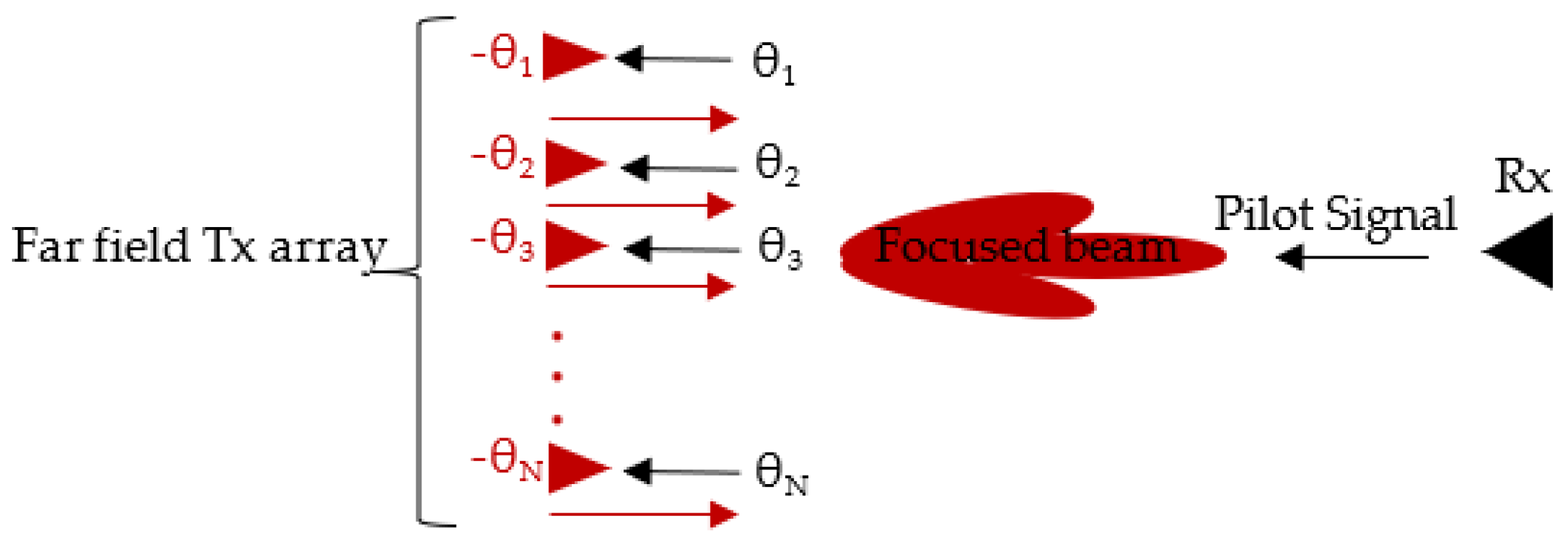
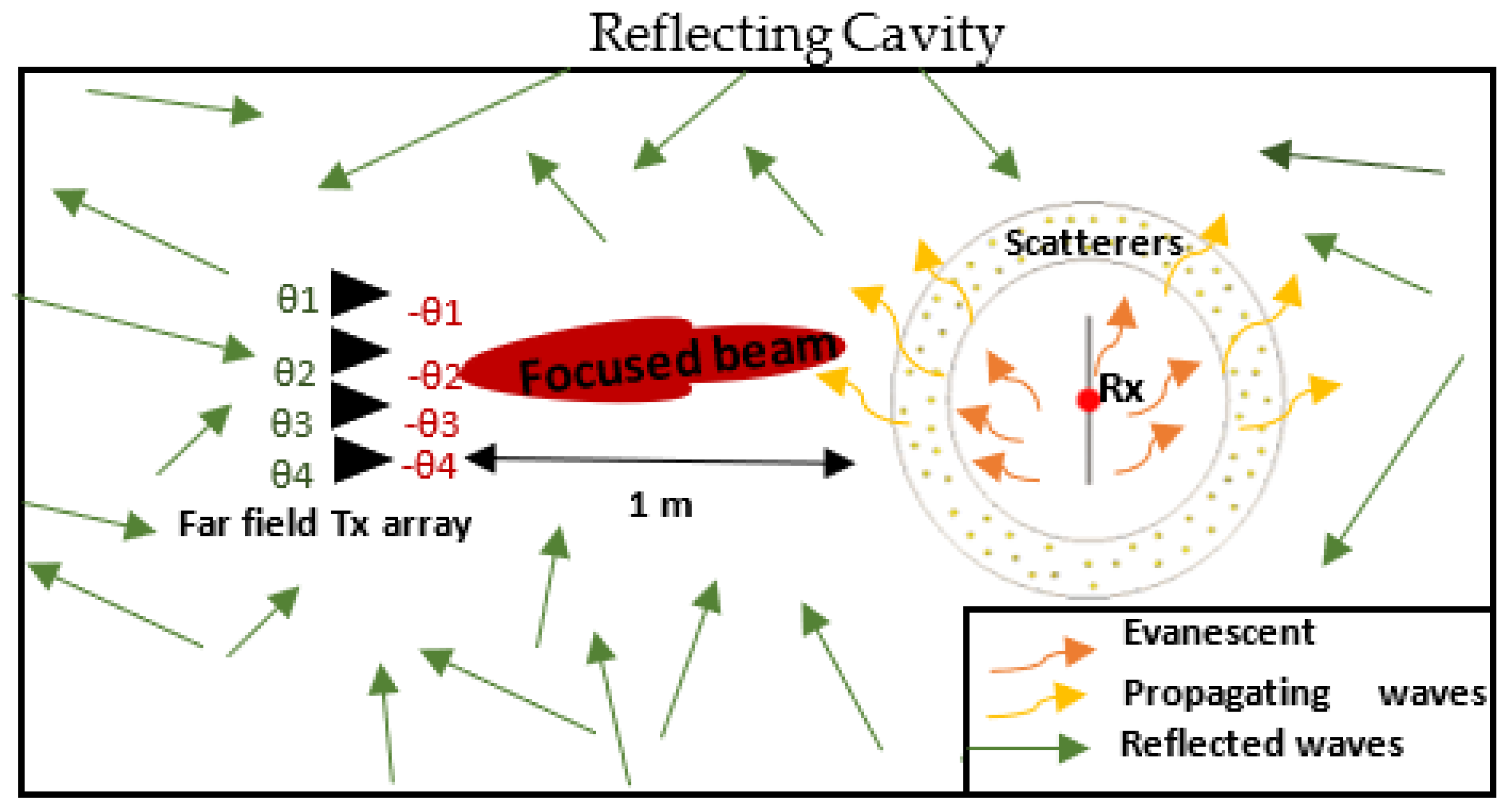
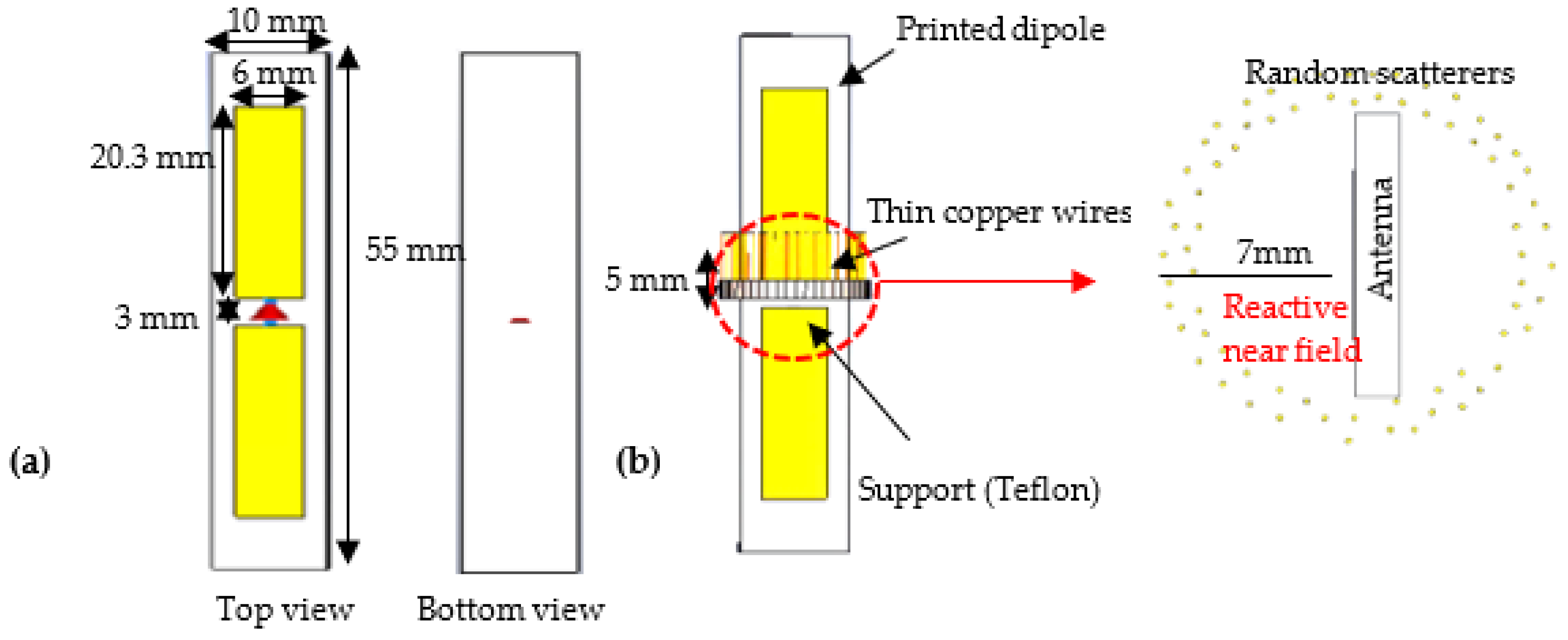
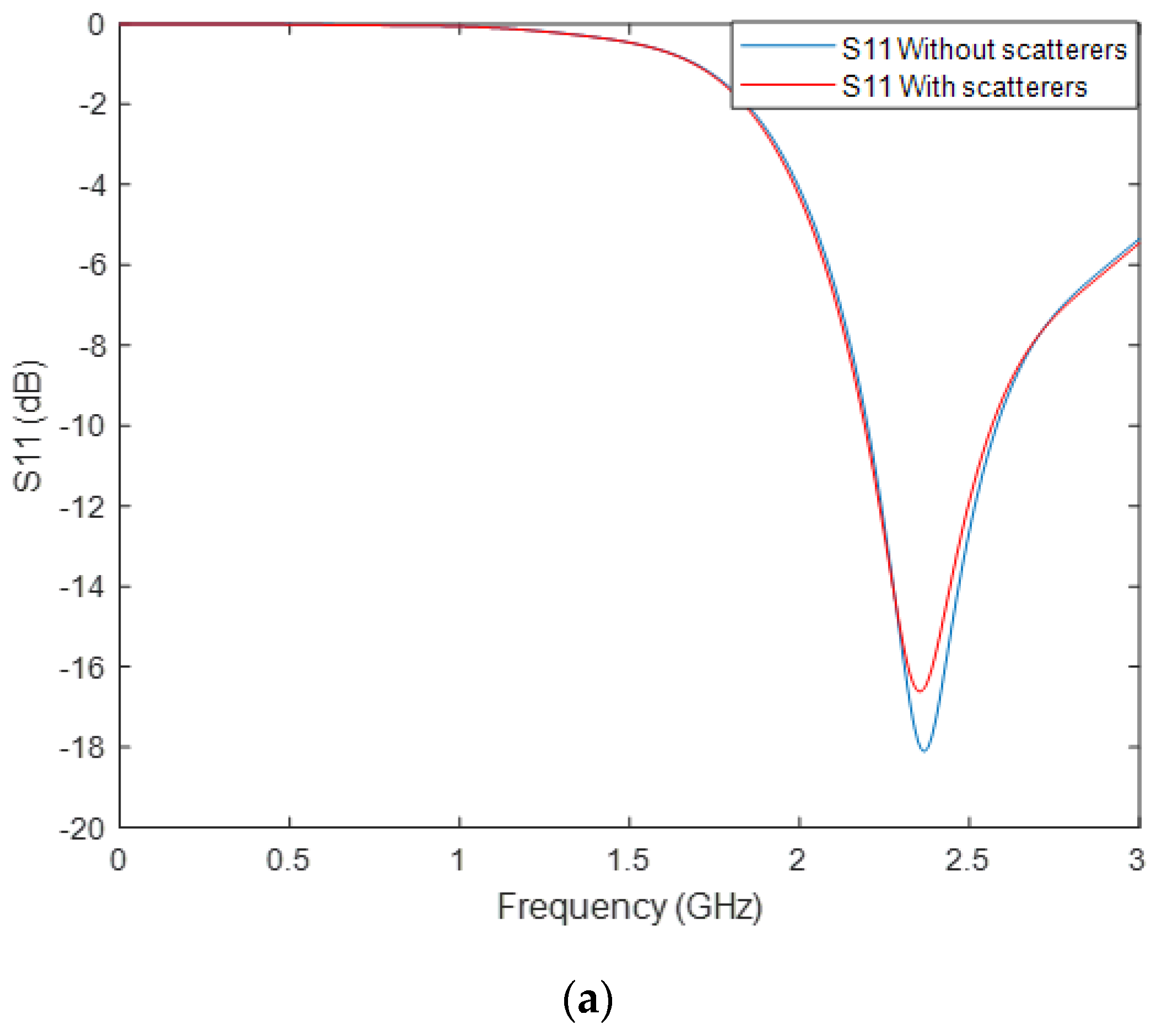
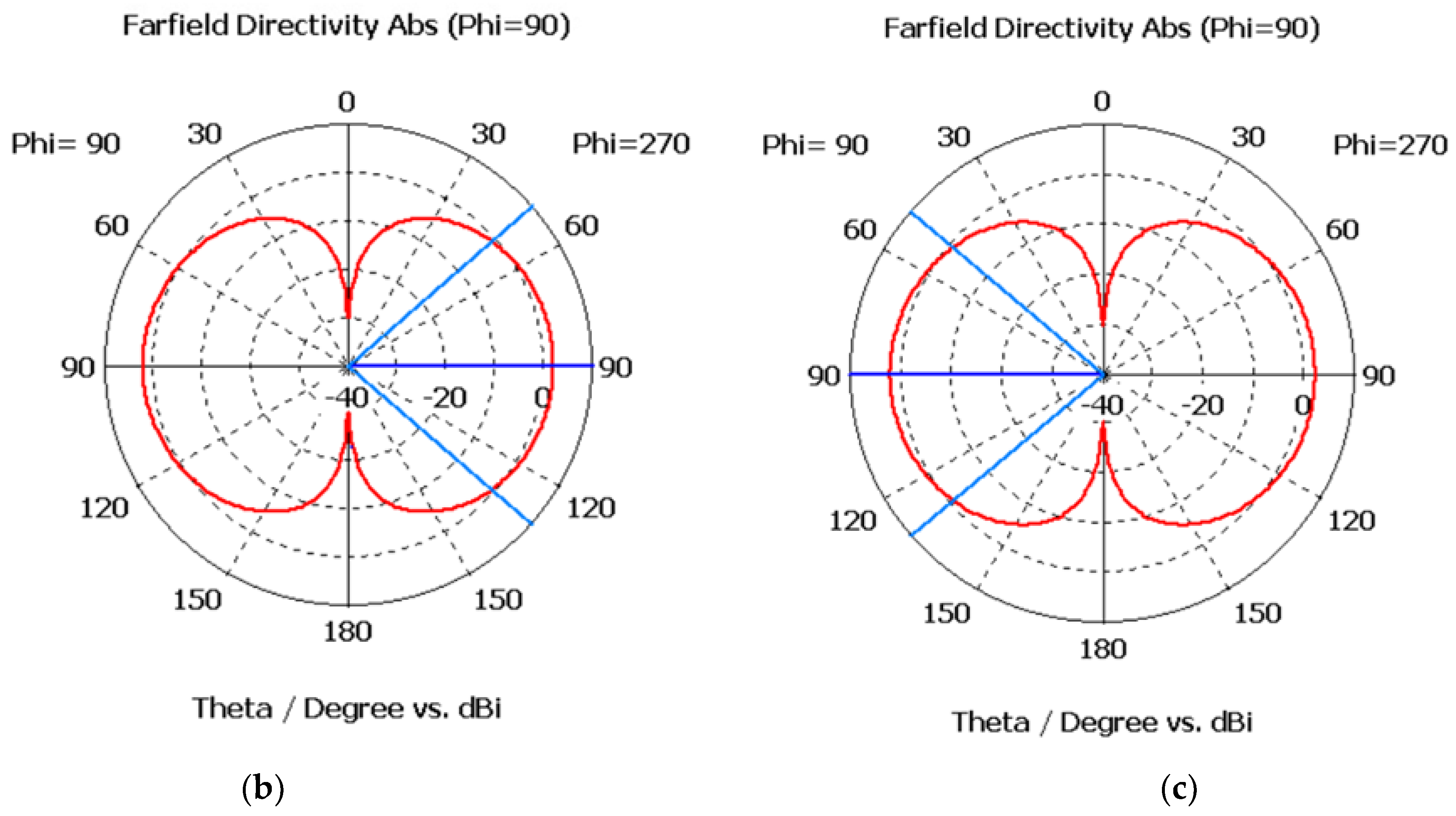
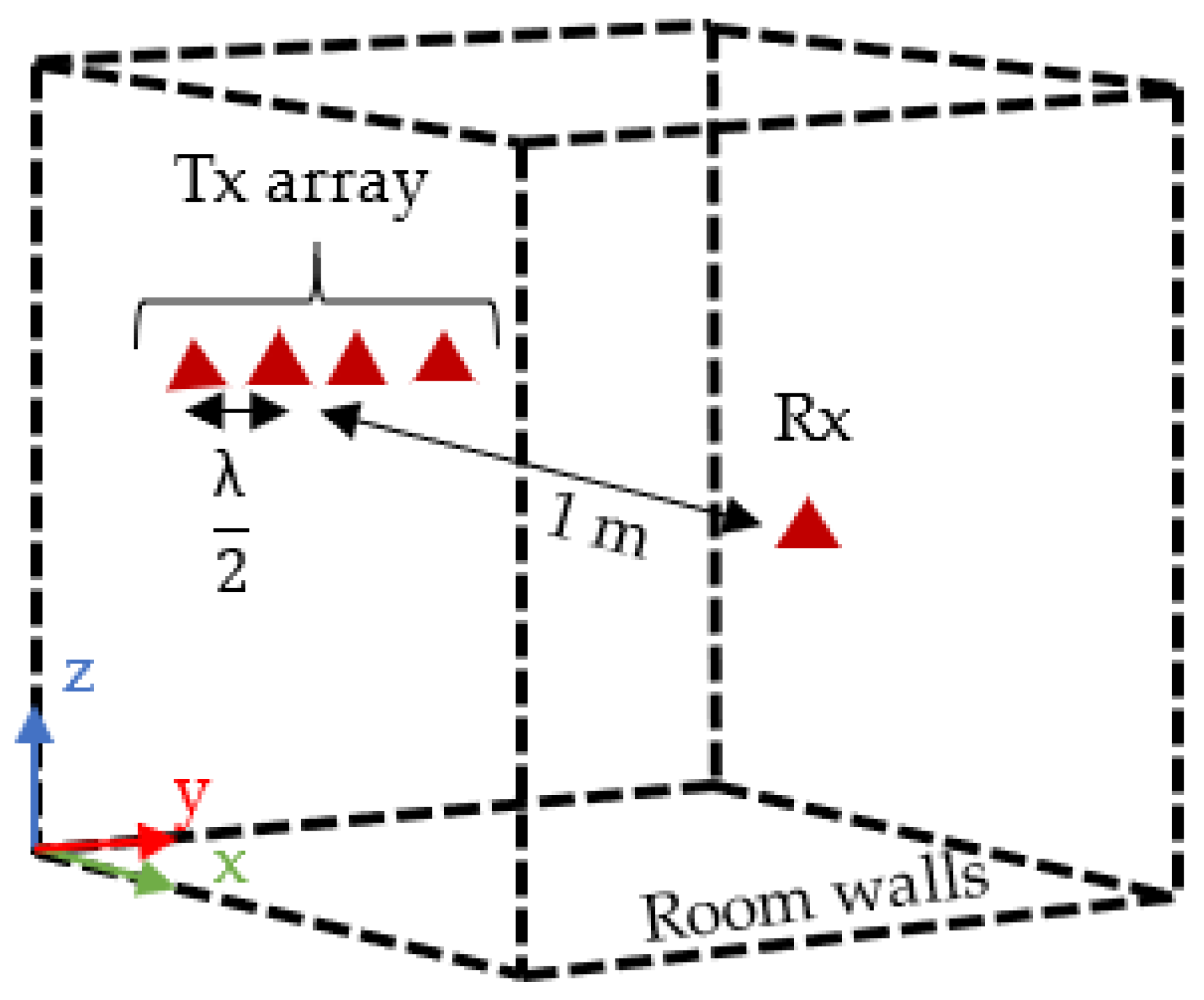
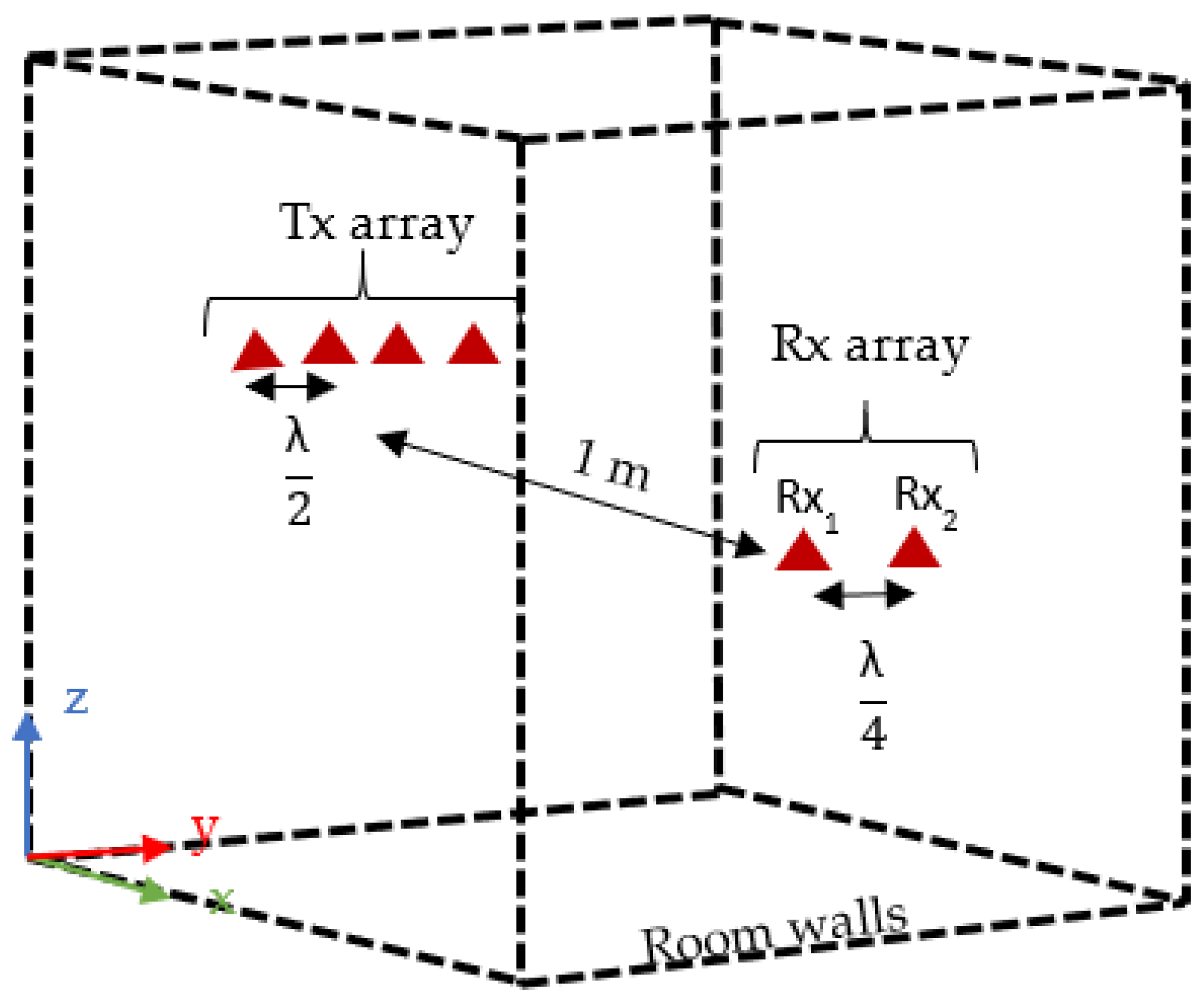
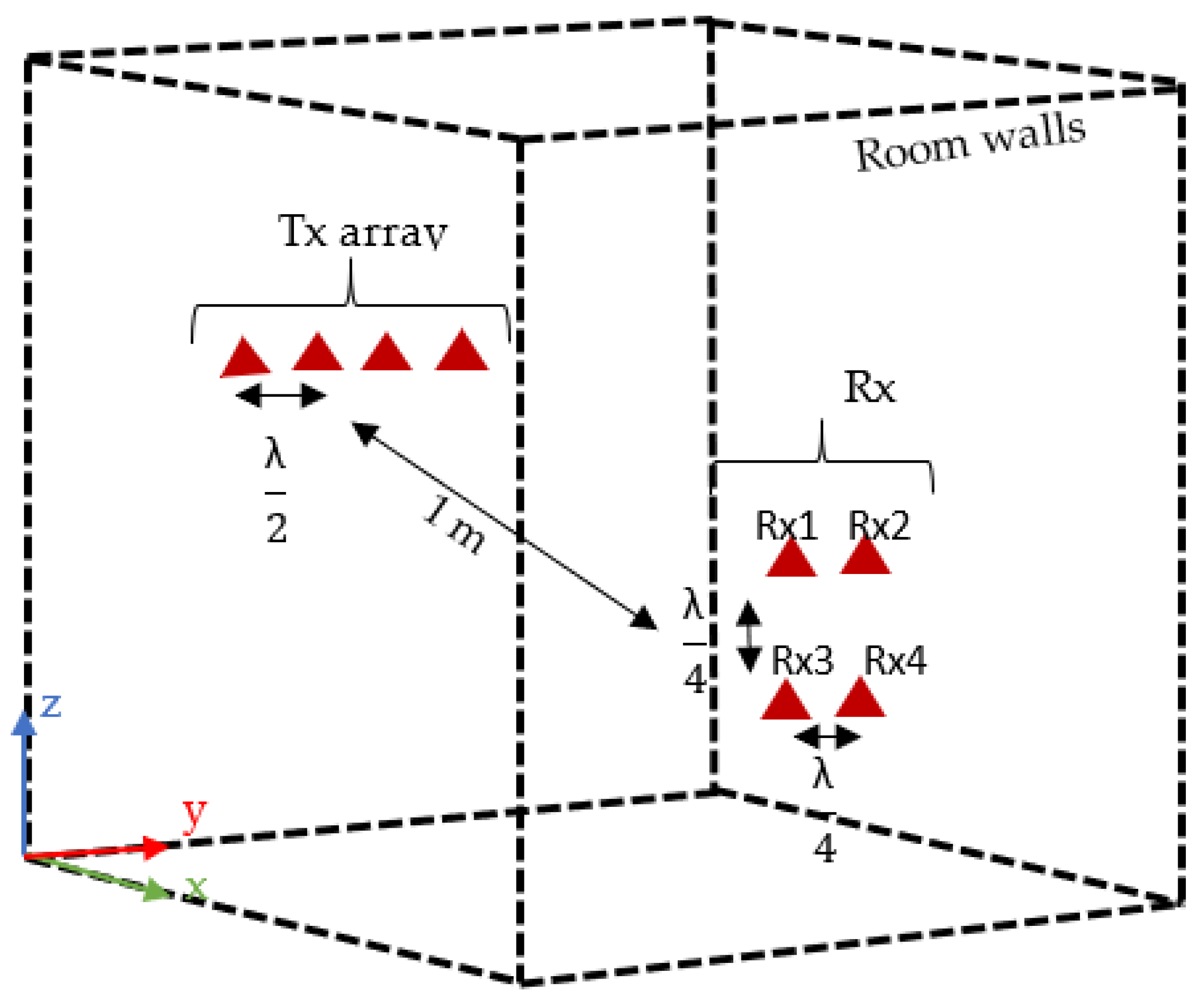

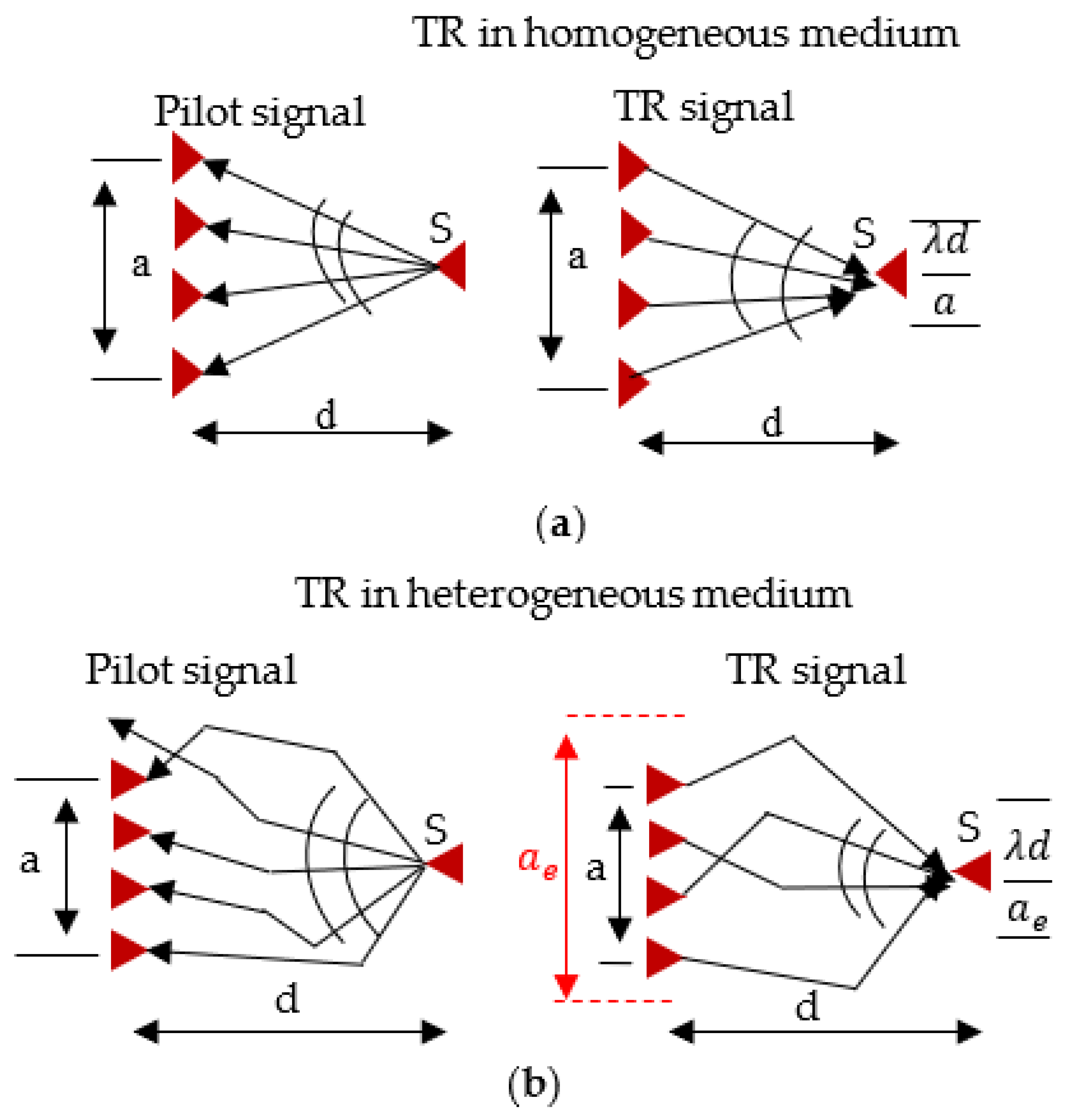
| Received Power (1 Rx) | Without Scatterers | With Scatterers |
|---|---|---|
| Homogenous medium | 6.82 × 10−4 | 2.42 × 10−4 |
| Heterogenous medium | 4.8 × 10−3 | 5.1 × 10−3 |
| Pavg | P(Rx1) | P(Rx2) |
|---|---|---|
| Homogeneous Medium | ||
| Without scatterers | 6 × 10−4 | 7.4 × 10−4 |
| With scatterers | 2.4 × 10−4 | 2.7 × 10−4 |
| Heterogeneous Medium | ||
| Without scatterers | 8.5 × 10−4 | 3.4 × 10−4 |
| With scatterers | 3.6 × 10−3 | 4.3 × 10−3 |
| Pavg | P(Rx1) | P(Rx2) | P(Rx3) | P(Rx4) |
|---|---|---|---|---|
| Homogeneous Medium | ||||
| Without scatterers | 1.9 × 10−3 | 2.2 × 10−3 | 1.5 × 10−3 | 1.7 × 10−3 |
| With scatterers | 1.8 × 10−3 | 2 × 10−3 | 1.4 × 10−3 | 1.6 × 10−3 |
| Heterogeneous Medium | ||||
| Without scatterers | 1.8 × 10−3 | 1.7 × 10−3 | 2.3 × 10−3 | 2.4 × 10−3 |
| With scatterers | 2.8 × 10−3 | 3 × 10−3 | 3.4 × 10−3 | 3.9 × 10−3 |
| Pavg | P(Rx1) | P(Rx2) | P(Rx3) | P(Rx4) |
|---|---|---|---|---|
| Homogeneous Medium | ||||
| Without scatterers | 8.3 × 10−6 | 5.6 × 10−5 | 3.4 × 10−5 | 2 × 10−4 |
| With scatterers | 8.3 × 10−6 | 6 × 10−5 | 3.6 × 10−5 | 2.2 × 10−4 |
| Heterogeneous Medium | ||||
| Without scatterers | 2.5 × 10−3 | 2.6 × 10−3 | 2 × 10−3 | 2.5 × 10−3 |
| With scatterers | 3.4 × 10−3 | 3.3 × 10−3 | 3 × 10−3 | 4 × 10−3 |
Publisher’s Note: MDPI stays neutral with regard to jurisdictional claims in published maps and institutional affiliations. |
© 2022 by the authors. Licensee MDPI, Basel, Switzerland. This article is an open access article distributed under the terms and conditions of the Creative Commons Attribution (CC BY) license (https://creativecommons.org/licenses/by/4.0/).
Share and Cite
Katbay, Z.; Sounas, D.; Ismail, M. Scatterers in the Rx Near Field for RF Energy Harvesting Efficiency Enhancement. Energies 2022, 15, 2109. https://doi.org/10.3390/en15062109
Katbay Z, Sounas D, Ismail M. Scatterers in the Rx Near Field for RF Energy Harvesting Efficiency Enhancement. Energies. 2022; 15(6):2109. https://doi.org/10.3390/en15062109
Chicago/Turabian StyleKatbay, Zahra, Dimitrios Sounas, and Mohammed Ismail. 2022. "Scatterers in the Rx Near Field for RF Energy Harvesting Efficiency Enhancement" Energies 15, no. 6: 2109. https://doi.org/10.3390/en15062109
APA StyleKatbay, Z., Sounas, D., & Ismail, M. (2022). Scatterers in the Rx Near Field for RF Energy Harvesting Efficiency Enhancement. Energies, 15(6), 2109. https://doi.org/10.3390/en15062109






